Similar presentations:
At The Shop
1. Diapositive 1
Supermarket2. Diapositive 2
fruit3. Diapositive 3
vegetables4. Diapositive 4
pizza(frozen
food)
5. Diapositive 5
sugar6. Diapositive 6
bread7. Diapositive 7
gerkins8. Diapositive 8
chocolate9. Diapositive 9
honey10. Diapositive 10
milk(dairy
products)
11. Diapositive 11
butter12. Diapositive 12
eggs13. Diapositive 13
jam14. Diapositive 14
oil(condiments)
15. Diapositive 15
pepper16. Diapositive 16
salt17. Diapositive 17
vinegar18. Diapositive 18
biscuits19. Diapositive 19
cheese20. Diapositive 20
cakes21. Diapositive 21
yogurts(desserts)
22. Diapositive 22
cannedfood
23. Diapositive 23
fish24. Diapositive 24
meat25. Diapositive 25
poultry26. Diapositive 26
poultry27. Diapositive 27
pasta28. Diapositive 28
bottledwater
29. Diapositive 29
wine(alcohol)
30. Diapositive 30
tea, coffee(beverages)
31. Diapositive 31
soap,cream
(toiletries)
32. Diapositive 32
at the cashout33. Diapositive 33
At the checkoutRead the signs above you before you get into a
line.
express checkout: For people buying a few
items. The sign will show how many items you
are allowed to have (1-12).
automatic checkout: You swipe and bag your
own groceries and pay with a credit card.
closed: Many stores use a lighting system to
show which cash-desks are open for service. If
the light is on, the cash-desk is open.
34. Diapositive 34
Most grocery stores offer a variety of optionsfor gathering and packing items.
Don’t be surprised if you have to buy your bags.
shopping trolley: trolley on wheels (you may have
to put a coin deposit in the slot)
basket: plastic container with handles; useful for
quick grocery trips when you only need a few items
box: sometimes available for free at the checkout
plastic or paper bags: you may have to pay for
these
reusable bags: bring your own (or buy and reuse)
35. Diapositive 35
Here are the main aisles (or sections) in a supermarket (or grocery store)as well as some example items of what you will find in them.
(fresh) produce: fresh fruit and vegetables
frozen food: pizzas, fruit and vegetables, ice-cream, etc
bulk food: olives, nuts (You put in bags yourself. You choose the amount.)
pre-packaged goods: flour, sugar, etc
bread: packaged bread, buns, etc
meat and seafood: beef, chicken, fish, etc
delicatessen: freshly sliced meats and cheeses (You tell the butcher how much you want.)
bakery: fresh breads, muffins, cakes, tarts, etc
dairy products: milk, eggs, yogurt, etc
pasta and rice: spaghetti, penne, wild rice, whole wheat pasta, etc
ethnic food: food from countries in other parts of the world
canned food: beans, pasta sauce, canned fruit and vegetables, tuna, etc
condiments: ketchup, sauces, salad dressings, oil, salt, pepper, etc
snacks: chips, peanuts, biscuits, crackers, etc
cereals: boxed breakfast cereals and bars, oats, etc
beverages: juice, coffee, tea, soda, etc
household items: toilet paper, tissues, rubbish bags, detergent, etc
health and beauty, toiletries: make up, deodorant, shampoo, etc
36. Diapositive 36
DiscountsDo you have a discount card (loyalty card in the UK)? Many shop assistants will ask
you for this. These cards are usually free. They provide you with a discount on
many items and give you points for gifts. If you are going to use this shop often, fill
in a form and get a card! It will be worth your time.
Brand-name items are normally more expensive than no-name or store-named
items.
Common Courtesy
- If the person behind you only has one or two items, you can invite the shopper to
go in front of you. Say, “You can go ahead of me. You’re just buying a few things.”
-If there is a divider (small stick) on the conveyor belt at the checkout, place it
after your items. This will allow the person behind you to start placing his or her
groceries down too.
Grocery Shopping Tips
Did you make out a list? Creating an English grocery list is a fun and simple way to
practise English. You can even create a master list using the sections above. Add
subcategories for all the food you normally buy. Leave extra spaces for special
items that you need once in a while.





































 english
english








